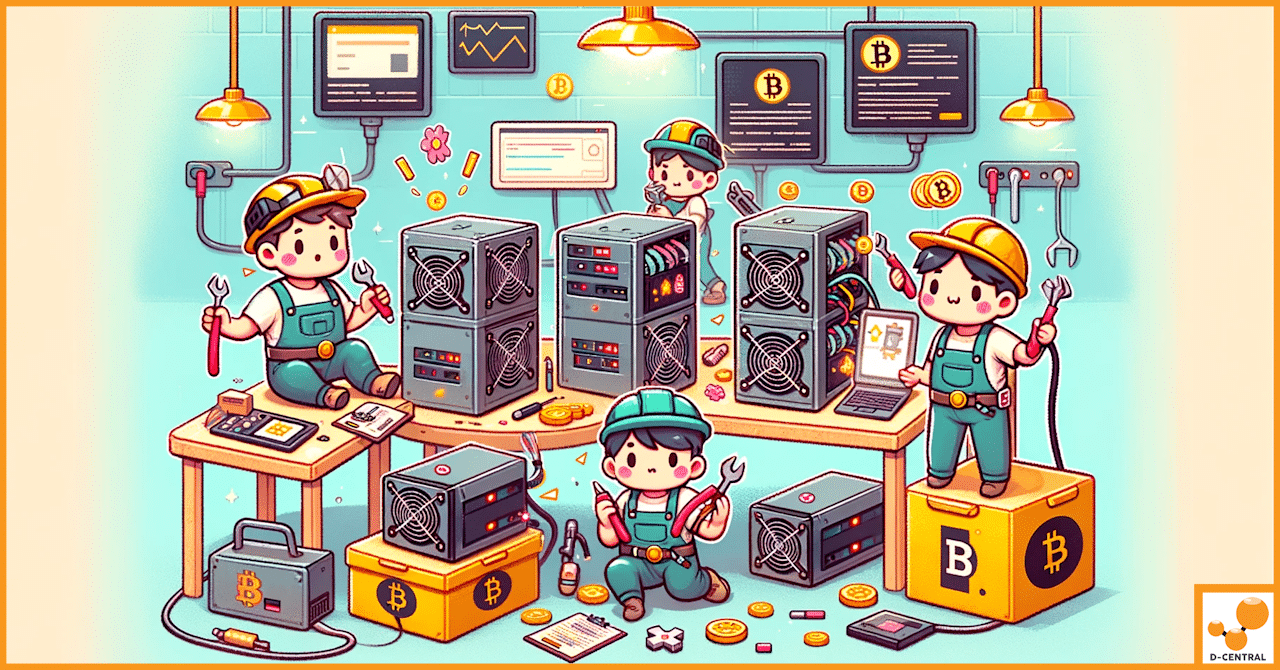
Securing Your Bitcoins: What You Need To Know About Self Custody
In the digital age, Bitcoin has emerged as a revolutionary financial instrument, reshaping our understanding of currency, transactions, and financial
4479 Desserte Nord Autoroute 440, Laval, QC H7P 6E2

The Antminer 19 Series, encompassing models like the S19, S19 Pro, S19j Pro, and S19 XP, represents a significant leap forward in the Bitcoin mining industry. Engineered by Bitmain, one of the leading manufacturers of cryptocurrency mining hardware, these advanced ASIC miners have set new standards for efficiency, power, and profitability in the competitive world of Bitcoin mining. With their unparalleled hash rates and energy efficiency, the Antminer 19 Series has become a cornerstone for both large-scale mining operations and individual miners aiming to maximize their returns in the ever-evolving cryptocurrency landscape.
However, as with any cutting-edge technology, users of the Antminer 19 Series face a range of common challenges. From the inherent unpredictability of the “silicon lottery” affecting ASIC chip performance to hardware issues such as temperature sensor failures, power supply instabilities, and thermal management concerns, these obstacles can significantly impact mining efficiency and operational uptime. Moreover, the complexity of troubleshooting and resolving these issues demands a deep understanding of the hardware and a meticulous approach to maintenance and repair.
Enter D-Central Technologies, a trailblazer in the Bitcoin mining sector and a leading expert in providing comprehensive solutions for these challenges. With a reputation built on reliability, expertise, and an unwavering commitment to the crypto community, D-Central Technologies stands at the forefront of ASIC repair and mining support. Whether it’s through offering detailed consultations, sourcing the latest mining hardware, hosting mining operations, or delivering top-tier ASIC repairs and maintenance training, D-Central Technologies has established itself as an indispensable resource for miners navigating the complexities of the Antminer 19 Series.
The Antminer 19 Series, developed by Bitmain, stands as a pinnacle of innovation in the realm of cryptocurrency mining hardware. This series includes several models, notably the S19, S19 Pro, S19j Pro, and S19 XP, each designed to cater to various mining needs and efficiency requirements. These models are distinguished by their hash rates and energy consumption ratios, making them suitable for different scales of mining operations.
The Antminer 19 Series plays a crucial role in the cryptocurrency mining ecosystem. These miners are engineered to solve complex cryptographic puzzles, a process central to the Bitcoin network’s transaction verification and blockchain integrity. By successfully solving these puzzles, miners are rewarded with newly minted bitcoins, making the efficiency and power of their mining hardware a critical factor in their profitability.
The introduction of the Antminer 19 Series has significantly impacted mining efficiency and profitability. With their high hash rates and optimized energy consumption, these miners have enabled individuals and mining farms to achieve greater returns on investment. The efficiency of the 19 Series reduces operational costs, particularly electricity expenses, which constitute a significant portion of mining overheads. Consequently, these advancements have not only bolstered the profitability of mining operations but have also contributed to the overall security and robustness of the Bitcoin network by increasing the computational power dedicated to transaction verification and block creation.
In summary, the Antminer 19 Series represents a leap forward in mining technology, offering miners the tools to maximize efficiency and profitability in the competitive landscape of cryptocurrency mining. With models like the S19, S19 Pro, S19j Pro, and S19 XP, Bitmain continues to push the boundaries of what is possible, reinforcing the importance of advanced hardware in achieving success in the mining industry.
The Antminer 19 Series, while being at the forefront of mining technology, is not without its challenges. Users often encounter several common problems that can affect their mining operations’ efficiency and profitability. Understanding these issues is crucial for maintaining optimal performance and ensuring the longevity of the mining hardware.
The term “silicon lottery” refers to the inherent variability in the manufacturing process of ASIC chips, which are the heart of Antminer devices. This variability means that even chips produced in the same batch can have different performance levels, affecting the overall efficiency of the miner. Some chips may achieve higher hash rates or consume less power than others, leading to a disparity in the performance of mining hardware. This lottery can impact the predictability of mining outcomes and necessitates a careful selection and optimization process to ensure that each miner operates at its best possible efficiency.
Hardware flaws, such as poor soldering, damaged components, or physical wear and tear, can significantly impact the performance of Antminer 19 Series devices. Identifying these issues often requires a visual inspection of the miner’s circuit boards and components. Solutions may include re-soldering loose connections, replacing damaged parts, or conducting thorough cleanings to remove dust and debris that could cause overheating or short circuits.
Temperature sensors play a vital role in monitoring and managing the heat generated by the mining process. Faulty sensors can lead to inaccurate temperature readings, causing miners to shut down prematurely or, conversely, to overheat and suffer damage. Common causes of sensor problems include physical damage, corrosion, or failure of the sensor itself. Troubleshooting steps may involve inspecting the sensors for visible damage, testing their functionality, or replacing them if necessary to ensure accurate temperature monitoring.
An unstable power supply can cause a range of issues for Antminer 19 Series users, from intermittent mining interruptions to complete shutdowns. Fluctuations in power quality or insufficient power output can prevent miners from operating at full capacity, reducing their hash rate and efficiency. Addressing power supply challenges may involve upgrading to a more robust power supply unit (PSU), ensuring stable and adequate power delivery, or implementing power conditioning tools to manage fluctuations and protect sensitive mining hardware.
Effective thermal management is critical for maintaining the longevity and efficiency of Antminer 19 Series devices. The application of thermal paste between the ASIC chips and their heat sinks is a key factor in this process. Improper application of thermal paste can lead to inadequate heat dissipation, causing chips to overheat and potentially fail. Common issues include using too little or too much thermal paste, or the paste drying out over time. Solutions involve carefully reapplying the correct amount of high-quality thermal paste and ensuring that heat sinks are securely attached to provide optimal cooling performance.
By addressing these common problems, users of the Antminer 19 Series can significantly improve their mining operations’ efficiency and reliability, ensuring that their investment continues to yield profitable returns in the competitive world of cryptocurrency mining.
Maintaining optimal performance of the Antminer 19 Series requires addressing various technical challenges that may arise during operation. This section provides a comprehensive guide to troubleshooting and resolving some of the most common issues, ensuring your mining hardware operates efficiently and reliably.
Step-by-Step Guide on Troubleshooting Fan Issues:
Strategies for Dealing with Abnormal PIC Readings and Missing Chips:
Solutions for Overcoming Network Failures and Ensuring Stable Connections:
Tips for Identifying and Fixing Power-Related Problems:
Guidelines for Preventing Overheating and Maintaining Optimal Operating Temperatures:
By following these troubleshooting steps and solutions, you can address the common problems faced by Antminer 19 Series users, ensuring stable and efficient mining operations.
Ensuring the longevity and efficiency of your Antminer 19 Series involves adopting a proactive approach to maintenance and care. By implementing regular maintenance routines, conducting thorough inspections, and staying updated with firmware, miners can significantly reduce the likelihood of encountering common problems. Here are essential preventive measures and best practices to help maintain your mining hardware in optimal condition.
By adhering to these preventive measures and best practices, miners can enhance the reliability, efficiency, and lifespan of their Antminer 19 Series devices. Regular maintenance, combined with a vigilant approach to monitoring and updates, forms the cornerstone of successful and profitable cryptocurrency mining operations.
In the intricate world of cryptocurrency mining, having a reliable partner to navigate the complexities of hardware maintenance and optimization can significantly impact your mining success. D-Central Technologies stands out as a beacon of expertise and support for miners, especially those utilizing the Antminer 19 Series. Here’s how D-Central Technologies can be your ally in maximizing mining efficiency and profitability.
D-Central Technologies offers a comprehensive suite of services tailored to the needs of Antminer 19 Series users. From troubleshooting and repair to optimization and hosting, D-Central provides end-to-end solutions to ensure your mining operations run smoothly and efficiently. Key services include:
Understanding the unique challenges faced by home miners, D-Central Technologies has developed innovative solutions to address common concerns:
Choosing D-Central Technologies for your Antminer 19 Series needs comes with numerous advantages:
In a landscape where efficiency, reliability, and innovation are key to success, D-Central Technologies emerges as a pivotal ally for Antminer 19 Series users. By leveraging D-Central’s expertise, miners can ensure their operations are not only profitable but also sustainable and forward-thinking.
The Antminer 19 Series represents a significant advancement in cryptocurrency mining technology, offering unparalleled efficiency and profitability to miners worldwide. However, like any sophisticated technology, it comes with its set of challenges that can impact performance and operational uptime. Addressing common problems such as hardware issues, power supply challenges, and thermal management is crucial for maintaining optimal mining performance and ensuring the longevity of your investment.
The value of expert support in navigating these challenges cannot be overstated. D-Central Technologies stands out as a premier provider of comprehensive solutions for the Antminer 19 Series, offering everything from ASIC repairs and maintenance to custom solutions like Bitcoin Space Heaters and silent fans for home mining. With a deep understanding of the intricacies of mining hardware and a commitment to innovation, D-Central Technologies is uniquely positioned to help miners maximize their efficiency and profitability.
Whether you’re facing technical difficulties with your Antminer 19 Series devices, looking to optimize your mining operations, or seeking innovative solutions to enhance your mining experience, D-Central Technologies offers the expertise and support you need. By choosing D-Central, you’re not just getting a service provider; you’re gaining a partner dedicated to helping you succeed in the competitive world of cryptocurrency mining.
We encourage all Antminer 19 Series users and those interested in maximizing their mining potential to reach out to D-Central Technologies. Explore the range of services, discover custom mining solutions, and take the first step towards optimizing your mining operations today.
For more information and to access expert mining support, visit D-Central Technologies’ website and their contact page for easy access to services. Let D-Central Technologies be your guide to a more profitable and efficient mining future.
What is the Antminer 19 Series?
The Antminer 19 Series, developed by Bitmain, is a collection of advanced ASIC miners including the S19, S19 Pro, S19j Pro, and S19 XP models. These miners are known for their high efficiency, power, and profitability, making them a popular choice for Bitcoin mining operations.
What common challenges do Antminer 19 Series users face?
Users of the Antminer 19 Series often face challenges such as the variability of ASIC chip performance known as the “silicon lottery,” hardware issues like temperature sensor failures and power supply instabilities, and the need for meticulous maintenance and repair.
How can D-Central Technologies assist Antminer 19 Series users?
D-Central Technologies offers a comprehensive suite of services for Antminer 19 Series users, including ASIC repair and maintenance, firmware updates and optimization, personalized mining consultation, and innovative solutions like Bitcoin Space Heaters and Silent Fans for home mining.
What are some tips for maintaining an Antminer 19 Series device?
Maintaining an Antminer 19 Series device involves regular cleaning, monitoring the operating environment, checking for firmware updates, conducting visual inspections, and using diagnostic tools to prevent common problems and maintain optimal performance.
Why choose D-Central Technologies for ASIC repairs and mining solutions?
Choosing D-Central Technologies provides Antminer 19 Series users with expertise and reliability, cost-effective solutions, innovative mining solutions, and comprehensive support, making it a valuable partner for maximizing mining efficiency and profitability.
DISCLAIMER: D-Central Technologies and its associated content, including this blog, do not serve as financial advisors or official investment advisors. The insights and opinions shared here or by any guests featured in our content are provided purely for informational and educational purposes. Such communications should not be interpreted as financial, investment, legal, tax, or any form of specific advice. We are committed to advancing the knowledge and understanding of Bitcoin and its potential impact on society. However, we urge our community to proceed with caution and informed judgment in all related endeavors.
Related Posts

In the digital age, Bitcoin has emerged as a revolutionary financial instrument, reshaping our understanding of currency, transactions, and financial

In the rapidly evolving world of cryptocurrency, Bitcoin mining has emerged as a cornerstone activity, driving the blockchain’s security and

Discover how D-Central Technologies is revolutionizing home cryptocurrency mining with energy-efficient, low power ASIC miners. Join us as we explore